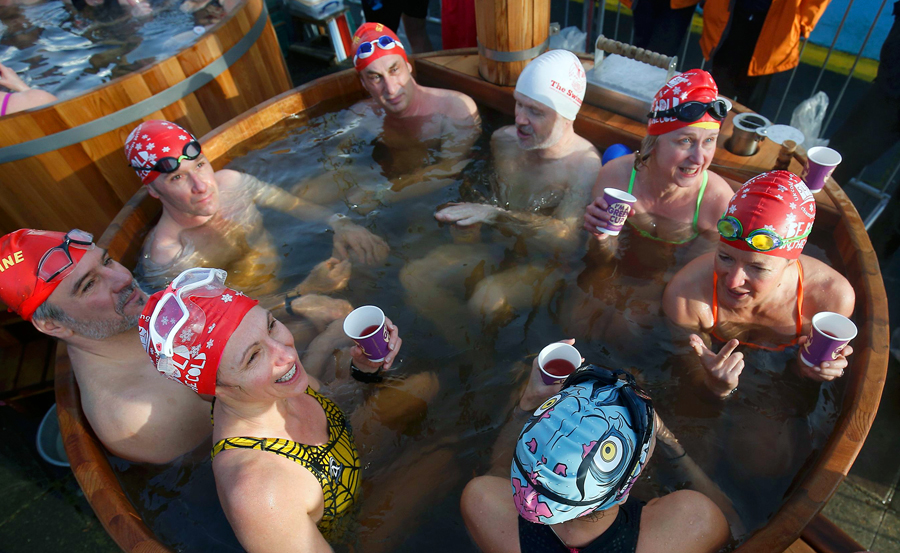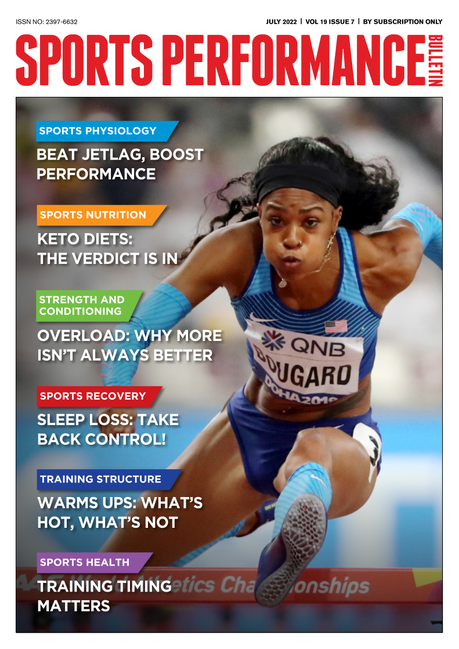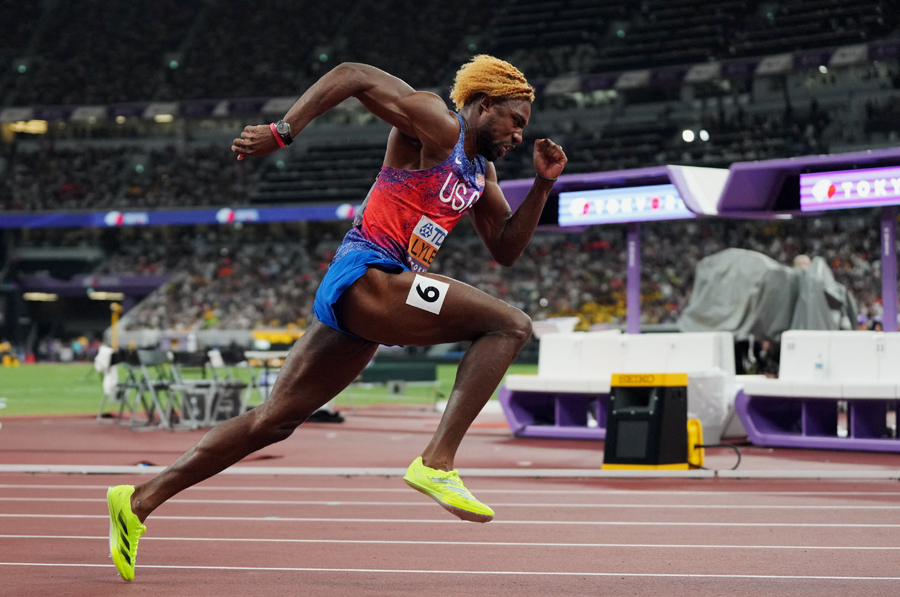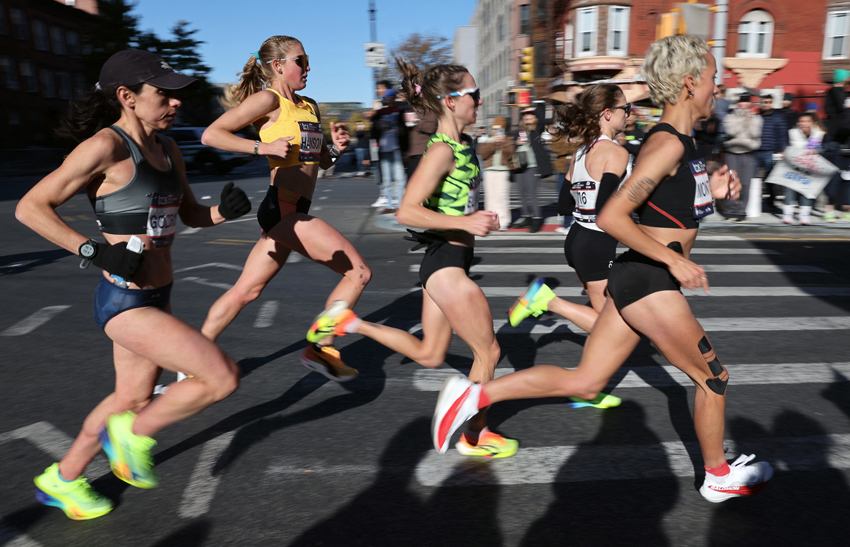Recovery and training adaptation: the hot-cold equation
Is post-exercise hot-water immersion a better recovery and performance option than cold-water immersion? SPB looks at new evidence
If you’re a northern hemisphere dweller where late July is high summer, you might well be struggling to train in the heat and humidity. But take heart because while high temperature and high humidity training can make you sweat copiously and feel sluggish as you try to shed excess heat, there’s a very large silver lining to be had. In a recent SPB article, which was published in our May 2025 issue, we looked at new research on how endurance training in the heat can induce similar improvements in endurance as those generated by training at altitude(1).
The power of heat
In the study we highlighted, athletes who trained for four weeks in high temperature and high humidity conditions [35°C (95F) and high humidity (70% relative humidity)] were compared with those who performed the same training for four weeks in temperate conditions, but where an altitude of 2,500m (8,200ft) was simulated. Although altitude training is known to stimulate extra training adaptations compared to sea level training (due to the lower oxygen content of air, which forces the muscles and circulatory system to become more efficient), the remarkable finding was that it was the heat training that produced the greatest gains.
Both modes resulted in a higher lactate threshold compared to normal training, meaning the athletes were able to sustain higher workloads before the rapid accumulation of fatiguing lactate. But it was only the heat training that resulted in an increase of VO2max (averaging around 0.24litres/minute - significant). In a similar vein, both interventions resulted in increased fat oxidation during exercise, but it was the heat intervention that produced the biggest boost to fat burning while training, increasing the maximum rate of fat burning to 59% of calories burned compared to a maximum rate of 55% of calories burned in the altitude intervention.
It has long been known that when endurance athletes train at moderate altitude (where the concentration of oxygen in the air is lower) for a period of time, a number of physiological responses occur, which over time can lead to positive endurance adaptations and a performance advantage when returning to sea level – most notably an increase in blood volume and haemoglobin(2,3). But what are the physiological changes produced by heat training that can improve performance?
Because heat training diverts blood away from muscles to the skin (to provide cooling), some physiologists argue that this creates a slight oxygen deficit in working muscles, forcing them to become more aerobically efficient – ie creating a similar stimulus as altitude training(4). In addition, a period of heat training can boost blood plasma volume, just as in altitude training(5). Finally, heat training is known to generate a phenomenon in the arteries known as ‘flow-mediated dilation’ effect(6). In layman’s terms, this dilation effect in arteries ‘stretches’ them, thus improving blood flow to working muscles – an effect that remains even when training or competition is resumed in cooler conditions.
The training adaptation effect
As well as the physiological effects and benefits of heat training (ie heat during exercise), some researchers have speculated that heat applied after exercise might help with post-exercise recovery and training adaptation The rationale for this theory is that recent research has shown that hot water immersion following resistance exercise results in a greater release of growth factor and the hormone testosterone, both of which play a role in muscle recovery and adaptation(7). Another reason is that while cold-water immersion is known to somewhat improve post-exercise recovery and blood lactate clearance(8), when it comes to training adaptation over a period of weeks or months, cold-water immersion may actually be harmful.
In a 2014 study, Aussie scientists found that regular 10-minute ice baths at 50°F after training sessions produced less muscle growth in cyclists than traditional low-intensity cool-downs(9). A similar finding came from a Japanese study, which found that when the forearm muscles and legs were immersed in ice-cold water after training, the strength and muscular endurance gains after six weeks were significantly less that when the limbs were immersed in temperate water at 18C (64F)(10). Scientists now believe that the reason for the poorer adaptation of muscles when they are immersed in cold water after exercise is down to the suppression of inflammation.
During hard exercise, micro-damage occurs within muscles. This damage is repaired during the recovery period but inflammation is an important part of this repair process. When inflammation is suppressed – for example, by making the muscles very cold after exercise - the recovery process is made more difficult. It was way back in 2002 that scientists discovered that anti-inflammatory medication such as Ibuprofen and acetaminophen inhibited protein synthesis in muscles after high-intensity exercise - presumably by blocking the inflammatory damage/repair cycle(11). More recently, the cold-water immersion effect of dampening training adaptations has been confirmed in other studies on athletes(12).
Heat for post-exercise training adaptation?
Given the above, some scientists have been speculating whether post-exercise hot-water immersion could better than cold-water immersion for recovery and training adaptations. Put simply, hot-water immersion doesn’t suppress inflammation yet seems able to increase growth factor and testosterone, while at the same time improving blood flow (helpful for lactate clearance from muscles). Therefore, it might be a more effective option to improve recovery and training adaptation benefits than cold-water immersion.
To test this theory, a team of Aussie scientists from Victoria University has carried out a new study investigating the use of hot-water immersion during post exercise recovery(13). Published in the ‘Journal of Thermal Biology’, this study compared the effects of 30 minutes of hot-water immersion (at 42C) to the same duration of thermo-neutral water immersion (at 34C – control condition) in trained to high-trained cyclists following bouts of high-intensity interval training (HIIT). Why was the control condition thermo-neutral water immersion rather than cold-water immersion? That’s because the effects of cold-water immersion are well understood and the researchers wanted to separate out the effect of hot-water immersion compared to no recovery strategy at all.
What they did
Fourteen trained male cyclists (from recreationally to highly trained) were recruited for the study, which lasted three weeks and consisted of nine sessions of HIIT even spread over the 3-week period (ie three sessions per week). All the training sessions began with a 10-minute light warm-up, after which a series of 5-minute intervals were performed at a power output corresponding to each cyclist’s lactate threshold. To ensure a progressive training stimulus during the training period, four intervals were completed during the first three training sessions, five intervals during the fourth, fifth and sixth sessions and six intervals during the last three sessions. The rest periods in between each effort involved active recovery, pedalling gently at 50 watts for one minute.
However, before the training sessions got underway, the cyclists were randomly divided into two groups as to how they recovered immediately after each HIIT session:
· Hot-water immersion group – these cyclists were immersed up to their chest (arms were not immersed) in a semi-recumbent posture for 30 minutes in an inflatable bath with continuous hot-water recirculation maintained at 42C (107.6F).
· Control group – exactly as above but where the water temperature was maintained at 34C (93.2F).
Before and after the 3-week HIIT intervention, all the cyclists performed an incremental test to exhaustion and a 20km time trial test at 18–20C to measure endurance performance, lactate threshold, peak oxygen uptake and whether/how much performance was improved in each group. In addition, pre- and post-intervention resting muscle biopsies were obtained from the vastus lateralis (the main quadriceps muscle recruited when cycling). This was to determine any changes in mitochondrial respiratory proteins (found in mitochondria [the energy factories in cells] and vital for the release of energy during aerobic metabolism) and mitochondrial respiration. The results from the two groups were then analyzed and compared.
The findings
The first finding was that the HIIT program resulted in faster 20km time trial times in both groups, with the hot-water immersion group averaging 1.5% faster, and the thermo-neutral immersion group 1.7% faster (see figure 1). However, statistically, these reductions were not different between the two groups meaning that the post-exercise hot-water immersion protocol had produced no additional endurance benefits. There was also no difference in hot-water immersion vs. thermo-neutral immersion when it came to the other determinants of endurance performance - lactate threshold, peak power output, and maximal oxygen consumption. In addition, no significant changes in the levels of markers of mitochondrial content and respiration were found in either group, suggesting that hot-water immersion had not deliver endurance benefits at the cellular level. The authors concluded that the nine HIIT sessions led to a significantly improved 20km time trial performance, but adding hot-water immersion after the HIIT sessions did not provide additional performance benefits.
Figure 1: Hot vs. thermo-neutral water immersion and power/time
A = time-trial power; B = time trial times. Blue = thermo-neutral; red = hot-water immersion. Each red/blue line = individual cyclist; black lines = average result for that group. Overall, there was no difference in gains between the hot and thermo-neutral immersion. This suggests that hot-water immersion does not enhance endurance performance adaptations, but it doesn’t inhibit adaptation either (as does cold-water immersion).
Practical information for athletes
In an ideal world, a recovery intervention following a training session would both accelerate recovery, helping athletes to be able to train hard again sooner, and maximize the training adaptations gained from that session. As we have seen, while cold-water immersion offers some recovery benefits, it may come with a price tag of reduced training adaptation, especially for muscle strength and endurance (obviously undesirable). So what about post-training hot-water immersion? In the study above, the researchers theorized that since exercise in the heat is known to produce additional endurance training adaptation gains, using heat post training over a period of weeks might also confer additional gains in terms of increased endurance performance. However, this was not the case; post-training hot-water immersion conferred no extra endurance benefits over the control condition.
However, this is not the whole story. Firstly, it’s important to point out that unlike cold-water immersion, there were no negative training adaptation effects (ie using hot-water immersion didn’t impair the endurance gains accrued from the 3-week HIIT program). Secondly, the researchers only measured the effect of hot-water immersion on time-trial performance and mitochondrial changes within muscle cells. As we mentioned above, research shows that hot water immersion following resistance exercise results in a greater release of growth factor and the hormone testosterone, both of which play a role in muscle recovery and adaptation(7). And if we look at other studies on this topic, there is good evidence that muscle strength and recovery may be enhanced by post-training hot-water immersion.
In a study on speed skaters, regular hot-water baths following training induced additional effects on maximal isometric strength of the quadriceps muscle without compromising aerobic and anaerobic adaptations or field performance in these athletes(14). Meanwhile, a study on elite badminton players and non athletes found that post-exercise hot-water immersion (40C) for 20 minutes was effective in reducing fatigue in both groups, and that the hot-water immersion was particularly effective at preventing muscle cell damage in athletes, as assessed by biomarkers like creatine kinase and lactate(15).
In a similar manner, the use of post-exercise far-infrared heat (using a special kind of infrared lamp that emits heat which can penetrate deep into muscles, much like a bath) improved recovery of maximal isometric leg press performance after a combined strength/endurance session, with significant reductions in heart rate and lactate concentration following the protocol(16). The far infrared heat also enhanced recovery of maximal oxygen uptake on a treadmill, indicating better recovery of aerobic capacity.
In summary then, what should athletes seeking maximum recovery do? Based on the evidence to date, the answer will depend on whether you are seeking a short-term benefit – for example needing to recover rapidly in a multiday competition – or whether you are needing a longer-term recovery strategy that can be used day in, day out. If it’s the former, cold-water immersion will likely produce the best short-term results. However, for a regular, longer-term recovery strategy, hot-water immersion looks to be preferable. Not only is it able to deliver recovery benefits, it has the advantage of NOT impairing training adaptation in the longer term. Indeed, there is some evidence that for muscle strength and local muscle endurance, hot-water immersion may actually enhance training adaptations. So when you next climb into a hot bath and relax, you can not only enjoy the relaxing sensation, you can also take comfort that it will be doing you good!
References
1. Eur J Sport Sci. 2025 May 8;25(6):e12312.
2. Sports Medicine 2009. 39, no. 2: 107–127
3. International Journal of Sports Physiology and Performance 2023. 18, no. 6: 563–572
4. Journal of Physiology 2008. 586, no. 1: 45–53
5. Sports Med 2007. 37(8):669-682
6. Physiol Rev 2017. 97: 495–528
7. Eur J Appl Physiol. 2024 Apr 13;124(9):2615–2628
8. Cochrane Database of Systematic Reviews 2012, Issue 2. Art. No.: CD008262
9. Journal of Physiology 2015. 50 593(18)
10. Eur J Appl Physiol (2006) 96: 572–580
11. American Journal of Physiology - Endocrinology and Metabolism, 1 March 2002 Vol. 282 no. 3, E551-E556
12. Front Sports Act Living. 2021 Jul 16:3:714148
13. J Therm Biol. 2025 Apr 23:131:104119. doi: 10.1016/j.jtherbio.2025.104119. Online ahead of print
14. J Exerc Sci Fit. 2021 Jan 12;19(2):134–142
15. Retos Aug 2024. 59:1046-1054
16. Springerplus. 2015 Jul 7:4:321
Newsletter Sign Up
Testimonials
Dr. Alexandra Fandetti-Robin, Back & Body Chiropractic
Elspeth Cowell MSCh DpodM SRCh HCPC reg
William Hunter, Nuffield Health
Newsletter Sign Up
Coaches Testimonials
Dr. Alexandra Fandetti-Robin, Back & Body Chiropractic
Elspeth Cowell MSCh DpodM SRCh HCPC reg
William Hunter, Nuffield Health
Keep up with latest sports science research and apply it to maximize performance
Today you have the chance to join a group of athletes, and sports coaches/trainers who all have something special in common...
They use the latest research to improve performance for themselves and their clients - both athletes and sports teams - with help from global specialists in the fields of sports science, sports medicine and sports psychology.
They do this by reading Sports Performance Bulletin, an easy-to-digest but serious-minded journal dedicated to high performance sports. SPB offers a wealth of information and insight into the latest research, in an easily-accessible and understood format, along with a wealth of practical recommendations.
*includes 3 coaching manuals
Get Inspired
All the latest techniques and approaches
Sports Performance Bulletin helps dedicated endurance athletes improve their performance. Sense-checking the latest sports science research, and sourcing evidence and case studies to support findings, Sports Performance Bulletin turns proven insights into easily digestible practical advice. Supporting athletes, coaches and professionals who wish to ensure their guidance and programmes are kept right up to date and based on credible science.












